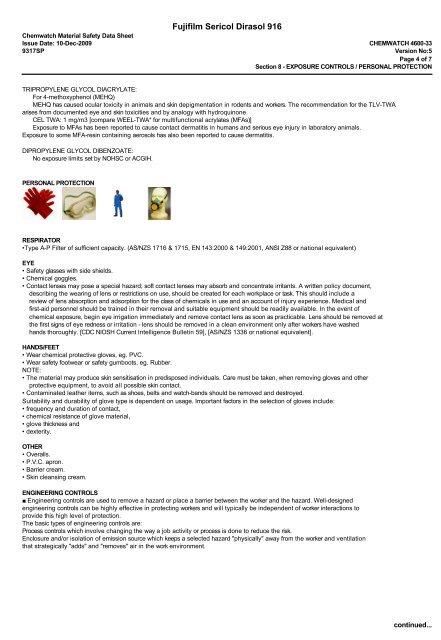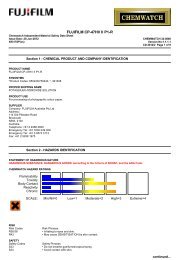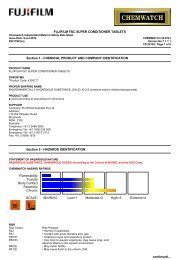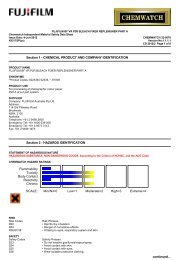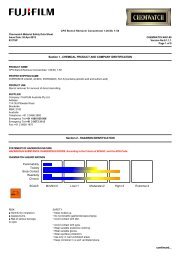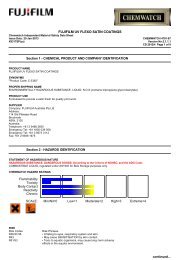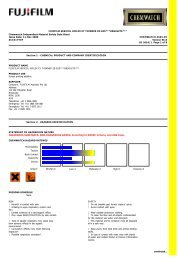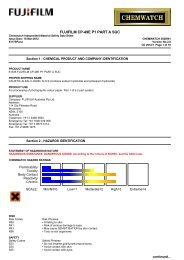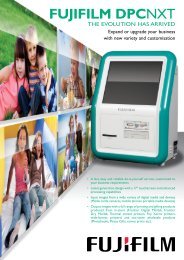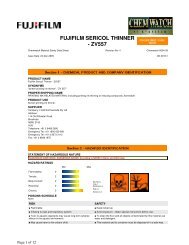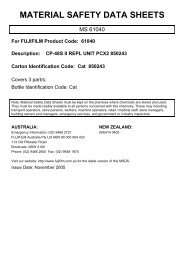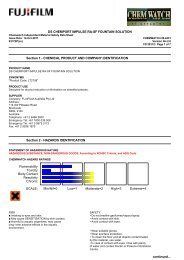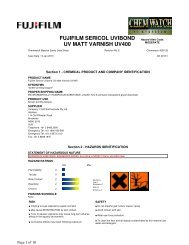Chemwatch MSDS Print - FUJIFILM Australia
Chemwatch MSDS Print - FUJIFILM Australia
Chemwatch MSDS Print - FUJIFILM Australia
Create successful ePaper yourself
Turn your PDF publications into a flip-book with our unique Google optimized e-Paper software.
Fujifilm Sericol Dirasol 916<br />
<strong>Chemwatch</strong> Material Safety Data Sheet<br />
Issue Date: 10-Dec-2009 CHEMWATCH 4600-33<br />
9317SP<br />
Version No:5<br />
Page 4 of 7<br />
Section 8 - EXPOSURE CONTROLS / PERSONAL PROTECTION<br />
TRIPROPYLENE GLYCOL DIACRYLATE:<br />
For 4-methoxyphenol (MEHQ)<br />
MEHQ has caused ocular toxicity in animals and skin depigmentation in rodents and workers. The recommendation for the TLV-TWA<br />
arises from documented eye and skin toxicities and by analogy with hydroquinone.<br />
CEL TWA: 1 mg/m3 [compare WEEL-TWA* for multifunctional acrylates (MFAs)]<br />
Exposure to MFAs has been reported to cause contact dermatitis in humans and serious eye injury in laboratory animals.<br />
Exposure to some MFA-resin containing aerosols has also been reported to cause dermatitis.<br />
DIPROPYLENE GLYCOL DIBENZOATE:<br />
No exposure limits set by NOHSC or ACGIH.<br />
PERSONAL PROTECTION<br />
RESPIRATOR<br />
•Type A-P Filter of sufficient capacity. (AS/NZS 1716 & 1715, EN 143:2000 & 149:2001, ANSI Z88 or national equivalent)<br />
EYE<br />
• Safety glasses with side shields.<br />
• Chemical goggles.<br />
• Contact lenses may pose a special hazard; soft contact lenses may absorb and concentrate irritants. A written policy document,<br />
describing the wearing of lens or restrictions on use, should be created for each workplace or task. This should include a<br />
review of lens absorption and adsorption for the class of chemicals in use and an account of injury experience. Medical and<br />
first-aid personnel should be trained in their removal and suitable equipment should be readily available. In the event of<br />
chemical exposure, begin eye irrigation immediately and remove contact lens as soon as practicable. Lens should be removed at<br />
the first signs of eye redness or irritation - lens should be removed in a clean environment only after workers have washed<br />
hands thoroughly. [CDC NIOSH Current Intelligence Bulletin 59], [AS/NZS 1336 or national equivalent].<br />
HANDS/FEET<br />
• Wear chemical protective gloves, eg. PVC.<br />
• Wear safety footwear or safety gumboots, eg. Rubber.<br />
NOTE:<br />
• The material may produce skin sensitisation in predisposed individuals. Care must be taken, when removing gloves and other<br />
protective equipment, to avoid all possible skin contact.<br />
• Contaminated leather items, such as shoes, belts and watch-bands should be removed and destroyed.<br />
Suitability and durability of glove type is dependent on usage. Important factors in the selection of gloves include:<br />
• frequency and duration of contact,<br />
• chemical resistance of glove material,<br />
• glove thickness and<br />
• dexterity.<br />
OTHER<br />
• Overalls.<br />
• P.V.C. apron.<br />
• Barrier cream.<br />
• Skin cleansing cream.<br />
ENGINEERING CONTROLS<br />
■ Engineering controls are used to remove a hazard or place a barrier between the worker and the hazard. Well-designed<br />
engineering controls can be highly effective in protecting workers and will typically be independent of worker interactions to<br />
provide this high level of protection.<br />
The basic types of engineering controls are:<br />
Process controls which involve changing the way a job activity or process is done to reduce the risk.<br />
Enclosure and/or isolation of emission source which keeps a selected hazard "physically" away from the worker and ventilation<br />
that strategically "adds" and "removes" air in the work environment.<br />
continued...


